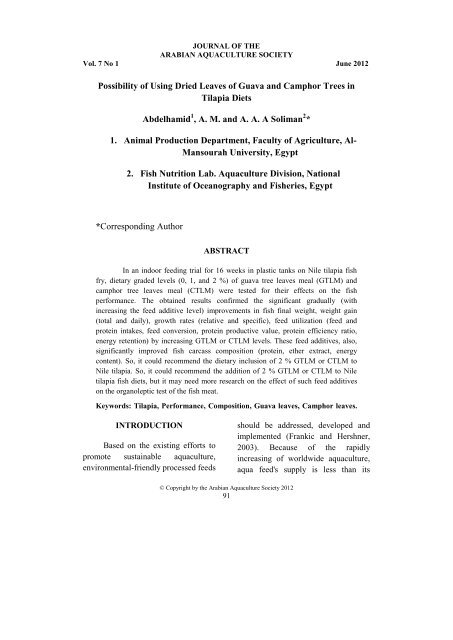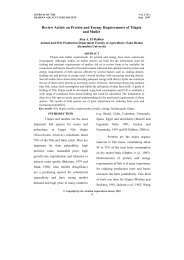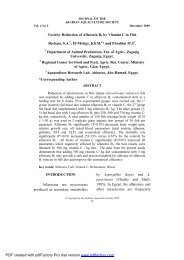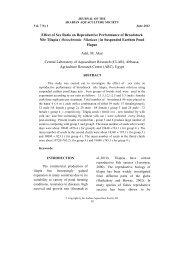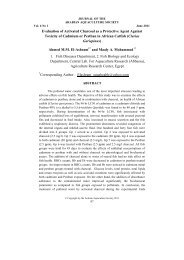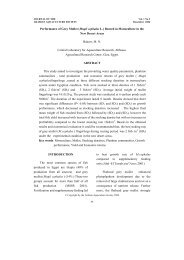Possibility of Using Dried Leaves of Guava and ... - Arabaqs.org
Possibility of Using Dried Leaves of Guava and ... - Arabaqs.org
Possibility of Using Dried Leaves of Guava and ... - Arabaqs.org
You also want an ePaper? Increase the reach of your titles
YUMPU automatically turns print PDFs into web optimized ePapers that Google loves.
JOURNAL OF THEARABIAN AQUACULTURE SOCIETYVol. 7 No 1 June 2012<strong>Possibility</strong> <strong>of</strong> <strong>Using</strong> <strong>Dried</strong> <strong>Leaves</strong> <strong>of</strong> <strong>Guava</strong> <strong>and</strong> Camphor Trees inTilapia DietsAbdelhamid 1 , A. M. <strong>and</strong> A. A. A Soliman 2 *1. Animal Production Department, Faculty <strong>of</strong> Agriculture, Al-Mansourah University, Egypt2. Fish Nutrition Lab. Aquaculture Division, NationalInstitute <strong>of</strong> Oceanography <strong>and</strong> Fisheries, Egypt*Corresponding AuthorABSTRACTIn an indoor feeding trial for 16 weeks in plastic tanks on Nile tilapia fishfry, dietary graded levels (0, 1, <strong>and</strong> 2 %) <strong>of</strong> guava tree leaves meal (GTLM) <strong>and</strong>camphor tree leaves meal (CTLM) were tested for their effects on the fishperformance. The obtained results confirmed the significant gradually (withincreasing the feed additive level) improvements in fish final weight, weight gain(total <strong>and</strong> daily), growth rates (relative <strong>and</strong> specific), feed utilization (feed <strong>and</strong>protein intakes, feed conversion, protein productive value, protein efficiency ratio,energy retention) by increasing GTLM or CTLM levels. These feed additives, also,significantly improved fish carcass composition (protein, ether extract, energycontent). So, it could recommend the dietary inclusion <strong>of</strong> 2 % GTLM or CTLM toNile tilapia. So, it could recommend the addition <strong>of</strong> 2 % GTLM or CTLM to Niletilapia fish diets, but it may need more research on the effect <strong>of</strong> such feed additiveson the <strong>org</strong>anoleptic test <strong>of</strong> the fish meat.Keywords: Tilapia, Performance, Composition, <strong>Guava</strong> leaves, Camphor leaves.INTRODUCTIONBased on the existing efforts topromote sustainable aquaculture,environmental-friendly processed feedsshould be addressed, developed <strong>and</strong>implemented (Frankic <strong>and</strong> Hershner,2003). Because <strong>of</strong> the rapidlyincreasing <strong>of</strong> worldwide aquaculture,aqua feed's supply is less than its© Copyright by the Arabian Aquaculture Society 201291
ABDELHAMID AND SOLIMANdem<strong>and</strong>; so, many efforts areundertaken to overcome this gap.Among these efforts is evaluation <strong>of</strong>novel feed sources, such recyclingsome valuable agro-industrial byproducts(Hussein et al., 2001; Soltan,2002; Hafez et al., 2003 <strong>and</strong> El-Komy,2006) or field crops' wastes (Srour etal., 2002) <strong>and</strong> recycling some medicalplants (Abd Elmonem et al., 2002; El-Komy, 2006 <strong>and</strong> Abd El-Hakim, 2008)whether to substitute one <strong>of</strong> theconventional feed stuffs in a diet or fortheir attractive or medical effects.Abou Khalifa (2009) mentioned thatrecycling waste is very important highvalue<strong>of</strong> food. Manufacturing <strong>of</strong> feedfrom industrial, plant waste is the keyto eliminate pollution from theenvironment. The process <strong>of</strong>manufacturing <strong>of</strong> animal <strong>and</strong> fish feed<strong>and</strong> fertilizer from recycling waste isthe most important factors foroperation <strong>of</strong> unemployment reduction.The traditional herbal remedyfrom Psidium guajava leaves has beenmedically proposed as effectivetreatment <strong>of</strong> acute diarrhea <strong>and</strong>dysentery. Also, guava leaf extractdecreased the frequency <strong>of</strong> cough, theextract directly stimulated musclecontraction. Moreover, growth <strong>of</strong>Staphylococcus aureus <strong>and</strong> β-streptococcus group A was inhibited byextract <strong>of</strong> dry guava leaves. Theseresults suggest that guava leaf extractis recommended as a cough remedy(Jaiarj et al., 1999). Abdelrahim et al.(2002) found also that Psidium guajavaextracts possess anti-bacterial activity.The extract <strong>of</strong> the leaves <strong>of</strong> Psidiumguajava was found to inhibit edema<strong>and</strong> pain <strong>and</strong> exhibited an antipyreticeffect. The extract reduced intestinaltransit time <strong>and</strong> prevented diarrhea(Olajide et al., 1999). However, guavashowed high content <strong>of</strong> polyphenols asnatural antioxidants (Jiménez-Escrig etal., 2001). Psidium guajava, is animportant food crop <strong>and</strong> medicinalplant in tropical <strong>and</strong> subtropicalcountries is widely used like food <strong>and</strong>in folk medicine around <strong>of</strong> the worldfor its chemical constituents,pharmacological, <strong>and</strong> clinical uses. Anumber <strong>of</strong> metabolites have beenshown to possess useful biologicalactivities belonging mainly to phenolic,flavonoid, carotenoid, terpenoid <strong>and</strong>triterpene. Extracts <strong>and</strong> metabolites <strong>of</strong>this plant, particularly those fromleaves <strong>and</strong> fruits possess usefulpharmacological activities. It is usedalso for hepatoprotection, anti-allergy,antigenotoxic, antiplasmodial,cytotoxic, antispasmodic, cardioactive,antiinflamatory <strong>and</strong> antinociceptiveactivities, supporting its traditionaluses (Pérez Gutiérrez et al., 2008).Camphor tree (Cinnamomumcamphora or Eucalyptuscamaldulensis) is traditionally used92
DRIED LEAVES OF GUAVA AND CAMPHOR TREES IN TILAPIA DIETSagainst cough, asthma <strong>and</strong> congestion.Several volatile <strong>and</strong> water-solubletoxins were found in Eucalyptustissues. Cineole <strong>and</strong> α-pinene arehighly toxic terpenes. Of 10 isolatedphenolic toxins, five were identified ascaffeic acid, chlorogenic acid, p-coumaric acid, ferulic acid, <strong>and</strong> gallicacid. There are factors permit toxinconcentrations to reach physiologicallysignificant proportions (Anon., 1970).The present work aimed to study theeffect <strong>of</strong> dietary graded levels <strong>of</strong> guavaor camphor tree leaves' meals on Niletilapia (Oreochromis niloticus) fishperformance <strong>and</strong> composition.MATERIALS AND METHODSAn indoor feeding experimentwas conducted to evaluate the dietaryinclusion <strong>of</strong> Pasidium guajava treeleaves meal (GTLM) or camphor treetree leaves meal (CTLM) concerninggrowth performance, carcasscomposition <strong>and</strong> feed utilization <strong>of</strong>Nile tilapia, Oreochromios niloticus,fry for 16 weeks. The experimentalsystem consisted <strong>of</strong> 15 plastic tanks(each <strong>of</strong> 16 liter water); each tank wascontinuously supplied with acompressed air from an electriccompressor (Shenzehe CompanyBS410). Dechlorinated tap water wasused to change one third <strong>of</strong> the water ineach tank every day. Water was aeratedbefore be used for about 24 hours toremove chlorine.Experimental Fish: A group <strong>of</strong>Nile tilapia O. niloticus with anaverage initial body weight <strong>of</strong> (0.28 –0.30 g) were obtained from a privatefarm at AL Hamoul, Kafr El-Sheikhgovernorate, Egypt <strong>and</strong> transported tothe wet lab. Fish were maintained inthese tanks for 2 weeks before thebeginning <strong>of</strong> the experiment foracclimatization purpose. The fish werefed during the acclimatization periodon the basal diet (30% crude protein) ata rate <strong>of</strong> 20% <strong>of</strong> the body weight daily,at 2 times daily. The experimentaltreatments were tested at three tanks(replicates) for each. Fish were stokedat a density <strong>of</strong> 7 fish / tank.Experimental Diet: ground driedleafs <strong>of</strong> Psidium guajava (GTLM) orcamphor (CTLM) were added (0, 1 <strong>and</strong>2%) to Nile tilapia fish diets. Allfeedstuffs used in the experimentaldiets were purchased from the localmarket. The basal diet No.1 wasconsidered as a control. Composition<strong>and</strong> chemical analysis <strong>of</strong> the basal <strong>and</strong>experimental diets are presented inTable 1 which showed that all theexperimental diets were iso-caloric <strong>and</strong>iso-nitrogenous. The composition <strong>of</strong>the vitamins <strong>and</strong> minerals mixture ispresented in Table 2.Experimental ProcedureThe experiment continued for 16weeks. During the experimental period,93
ABDELHAMID AND SOLIMANTable 1: Composition (%) <strong>and</strong> chemical analysis (% dry matter bases) <strong>of</strong> the experimentaldiets.IngredientsDiet No. 1 Diets No. 2 & 4 Diets No. 3 & 5Control GTLM (1%) GTLM (2%)Fish meal777Soybean meal505050Yellow corn232221Wheat bran151515GTLM or CTLM012Sunflower oil222Vitamins & minerals333Chemical analysisDry matter (DM)90.0189.8789.93Crude protein (CP)29.6129.9129.31Ether extract (EE)4.945.025.05Ash4.744.614.56Crude fiber (CF)10.169.9510.44Nitrogen free extract (NFE)50.5550.5150.64Gross energy (GE)*(kcal/100 g DM)420.96425.63421.10Protein/energy (P/E) ratio(mg CP/kcal GE)70.3370.2769.60Metabolizable energy(ME)** (kcal/100g)349.73353.20349.52*GE (kcal/100 g DM) = CP x 5.64 + EE x 9.44 + NFE x 4.11 calculated according to(Macdonald et al., 1973)**ME (kcal/100g DM) = Metabolically energy was calculated by using factors 3.49, 8.1 <strong>and</strong>4.5 kcal/g for carbohydrates, fat <strong>and</strong> protein, respectively according to Pantha (1982).94
DRIED LEAVES OF GUAVA AND CAMPHOR TREES IN TILAPIA DIETSTable 2: Composition <strong>of</strong> the vitamins <strong>and</strong> minerals mixture*(calculated for each kg <strong>of</strong> themixture) in the diets.Vitamins:AD 3EK 3B 1B 2B 6B 12CBiotinFolic acidPantothenic acidPhosphorusManganeseZincIronCopperCobaltSeleniumIodineStarchNatural. H.CaCo 3Minerals:Inert essential agent:*: Multi Vita Co. Animal Nutrition, 6 October city, 2 nd Industrial district.5.714.286 IU85.714 IU7.143 mg1.429 mg571 mg343 mg571 mg7.143 μg857 μg2.857 mg86 mg1.143 mg28.571 mg68.571 mg51.429 mg34.286 mg5.714 mg229 mg286 mg114 mg57 g29 gUp to 1000 g95
ABDELHAMID AND SOLIMANthe fish were fed the experimental dietsat a rate <strong>of</strong> 20% <strong>of</strong> the live body weightdaily. The diet was introduced twicedaily, at 8 a.m. <strong>and</strong> 2 p.m. The amount<strong>of</strong> feed was adjusted weekly based onthe actual body weight changes.Samples <strong>of</strong> water were taken from eachtank to determine water qualityparameters. Light was controlled by atimer to provide a 14 h light: 10 h darkas a daily photoperiod.Analytical MethodsSamples <strong>of</strong> water from eachaquarium were taken to determine thewater temperature, pH value, <strong>and</strong>dissolved oxygen concentrationsaccording to Abdelhamid (1996).Water temperature in degree centigradewas recorded every day by using athermometer. The pH value <strong>of</strong> waterwas measured daily using an electricdigital pH meter (Jenway Ltd, model350-pH meter). Dissolved oxygenconcentration was determined weeklyusing an oxygen meter model (d-5509).Determinations <strong>of</strong> DM, CP, EE, CF,<strong>and</strong> ash in the diets <strong>and</strong> in fish body atthe start <strong>and</strong> at the end <strong>of</strong> theexperiment for different groups werecarried out according to the methods <strong>of</strong>A.OA.C. (1990). At the end <strong>of</strong> theexperiment, three fish were derivedfrom each group (tank) for drying at60ºC for 48 hours <strong>and</strong> then milledthrough electrical mill <strong>and</strong> kept at 4 o Cuntil analysis.Growth Performance <strong>and</strong> Efficiency<strong>of</strong> Feed <strong>and</strong> Protein UtilizationThe growth performance <strong>and</strong>feed utilization parameters werecalculated according to the followingequations:Average weight gain (AWG, g/fish) =Average final weight (g)-Averageinitial weight (g).Average daily gain (ADG, mg/fish) =[Average final weight (g)-Averageinitial weight (g)] 1000 / Time(days).Survival rate (SR %) = Total number<strong>of</strong> fish at the end <strong>of</strong> theexperiment×100/total number <strong>of</strong>fish at the start <strong>of</strong> the experiment.Relative growth rate (RGR) =Average weight gain (g) / Averageinitial weight (g).Specific growth rate (SGR, % / day) =100 [ln wt 1 - ln wt o /T].Where: ln: Natural log. Wt o : Initialweight (g), Wt 1 : Final weight (g),<strong>and</strong> T: Time in days.Feed conversion ratio (FCR) = Totalfeed consumption (g) /Weightgain (g).Protein efficiency ratio (PER) = Bodyweight gain (g)/protein intake (g).96
DRIED LEAVES OF GUAVA AND CAMPHOR TREES IN TILAPIA DIETSProtein productive value (PPV %) =100 [Retained protein (g)/proteinintake (g)].Energy retention (ER %) = 100[Retained energy (Kcal) / Energyintake (Kcal)].Statistical analysisThe data were statisticallyanalyzed using General Linear Models(GLM) procedure adapted by SAS(1996) for users guide. Means wereseparated using Duncan's multiplerange test (Duncan, 1955).RESULTS AND DISCUSSIONWater qualityWater quality parametersmeasured (temperature, pH <strong>and</strong>dissolved oxygen) did not differ amongtreatments (Table 3). Values <strong>of</strong> themeasured criteria were within thenormal-suitable ranges for rearing Niletilapia fish (being 24 – 26 ºC, 7.5 – 8.5,<strong>and</strong> 5 – 6 mg/l, respectively) accordingto Abdelhamid (2009).Growth performanceTables 4 <strong>and</strong> 5 illustrate themeans ± st<strong>and</strong>ard errors <strong>of</strong> the testedgrowth performance parameters. Thedietary inclusion <strong>of</strong> guava or camphorleaves' meals (particularly at 2 % level)significantly (P≤0.05) improved each<strong>of</strong> final weight (FW), average weightgain (AWG), <strong>and</strong> average daily gain(ADG) as shown in Table 4 as well asrelative growth rate (RGR) <strong>and</strong> specificgrowth rate (SGR) as given in Table 5Table 3: Means <strong>of</strong> some water quality criteria in the experimental fish tanksTreatmentsParametersControlGTLM or CTLM(1%)GTLM or CTLM(2%)Temperature, ºC24-2624-2624-26The pH value7.5 – 8.57.5 – 8.57.5 – 8.5DO, mg/l5 - 65 - 65 - 697
ABDELHAMID AND SOLIMANTable 4: Means* <strong>of</strong> some growth performance parameters <strong>of</strong> the experimental fish, duringthe present study.TreatmentsI W,g / fishF W,g / fishAWG,g / fishADG,mg / fish / dayControl0.28 a2.0 c1.79 c14.92 c<strong>Guava</strong> (1%)0.28 a3.64 b3.36 b28.00 b<strong>Guava</strong> (2%)0.28 a4.38 a4.10 a34.17 aCamphor (1)0.28 a3.29 b3.00 b25.00 bCamphor (2)0.29 a4.39 a3.98 a33.17 a* a-c: Means (in the same column) superscripted with different letterssignificantly (P≤0.05) differed.IW: initial weight, FW: final weight, AWG: average weight gain, ADG: average dailygain.Table 5: Means* <strong>of</strong> relative growth rate (RGR), specific growth rate (SGR) <strong>and</strong> survival(SR) rate <strong>of</strong> the experimental fish, during the present study.TreatmentsRGRSGR, %/dSR%Control8.66 d0.35 c100 a<strong>Guava</strong> (1%)11.99 b1.19 b100 a<strong>Guava</strong> (2%)14.66 a1.37 a100 aCamphor (1)10.5 c1.09 b100 aCamphor (2)13.42 a1.38 a100 a* a-d: Means (in the same column) superscripted with different letters significantly(P≤0.05) differed.98
DRIED LEAVES OF GUAVA AND CAMPHOR TREES IN TILAPIA DIETScomparing with the control.Meanwhile, there were no significant(P≥0.05) differences among treatmentsin the survival rate (SR). However,dietary inclusion <strong>of</strong> medicinal plants(garlic, El-Saidy <strong>and</strong> Gaber, 1997;onion <strong>and</strong> garlic, Zaki <strong>and</strong> El-Ebiary,2003; Allium sativum <strong>and</strong> Thymusvulgaris, Attalla, 2009a) <strong>of</strong>tenincreases fish performance, nutrientsutilization, <strong>and</strong> chemical composition.In this respect, Arima <strong>and</strong> Danno(2002) isolated four antibacterialcompounds from guava leaves whichmay be responsible for improving fishgrowth. Similar results were obtainedby El-Dakar et al. (2004a) who foundthat 2% dietary inclusion <strong>of</strong> dried basilleaves was palatable <strong>and</strong> improveddigestibility <strong>of</strong> protein <strong>and</strong> energy, soincreased weight gain, SGR, feedefficiency, <strong>and</strong> PER. Additionally, El-Dakar et al. (2004b) reported that 2%dried marjoram leaves in the diet <strong>of</strong>hybrid tilapia fingerlings significantlyenhanced all fish growth performance<strong>and</strong> feed <strong>and</strong> nutrients utilizationparameters. Also, Abd El-Hakim(2008) fed brood stock tilapia fish onlicorice or ginger included diets thatimproved fry performance. Since 1 %addition level led to better final weight,gain, SGR, survival <strong>and</strong> feedconversion. Moreover, Attalla (2009b)mentioned also that feeding with amixture <strong>of</strong> ginger (powder <strong>and</strong> oilextract) can promote all growthparameters <strong>and</strong> decrease mortality rate<strong>of</strong> Nile tilapia.Feed utilizationBoth additives significantly(P≤0.05) improved each <strong>of</strong> feed intake,feed conversion ratio (FCR), proteinintake, protein productive value (PPV),protein efficiency ratio (PER), <strong>and</strong>energy retention (ER) comparing withthe control <strong>and</strong> proportional to theincrease in the additive level in thediets as presented in Table 6. However,dietary inclusion <strong>of</strong> medicinal plants(garlic, El-Saidy <strong>and</strong> Gaber, 1997;onion <strong>and</strong> garlic, Zaki <strong>and</strong> El-Ebiary,2003; Allium sativum <strong>and</strong> Thymusvulgaris, Attalla, 2009a) <strong>of</strong>tenincreases fish performance, nutrientsutilization, <strong>and</strong> chemical composition.Gaber (2000) concluded that 8 mgclove oil/100g diet significantlyincreased weight, length, feedefficiency, <strong>and</strong> protein <strong>and</strong> fat contents<strong>of</strong> flesh <strong>of</strong> Nile tilapia fingerlingscomparing with the control. El-Dakaret al. (2004a) found that 2% dietaryinclusion <strong>of</strong> dried basil leaves waspalatable <strong>and</strong> improved digestibility <strong>of</strong>protein <strong>and</strong> energy, so increasedweight gain, SGR, feed efficiency, <strong>and</strong>PER. El-Dakar et al. (2004a) foundthat 2% dietary inclusion <strong>of</strong> dried basilleaves was palatable <strong>and</strong> improveddigestibility <strong>of</strong> protein <strong>and</strong> energy, so99
ABDELHAMID AND SOLIMANTable 6: Means* <strong>of</strong> feed utilization parameters <strong>of</strong> the experimental fish, during thepresent study.Treatments(No.)Feed Intakeg/fishFCRProteinIntake, g/fishPPV%PERE R%Control12.75 c7.01 a3.77 c19.43 c0.47 b29.95 d<strong>Guava</strong> (1%)15.65 ab4.65 b4.63 ab31.14 a0.72 a72.99 b<strong>Guava</strong> (2%)18.11 a4.41 b5.36 a32.10 a0.76 a91.71 aCamphor (1)14.61 b4.86 b4.32 b29.57 b0.69 a48.47 cCamphor (2)18.92 a4.74 b5.59 a31.59 a0.71 a51.13 c* a-d: Means (in the same column) superscripted with different letters significantly(P≤0.05) differ.increased weight gain, SGR, feedefficiency, <strong>and</strong> PER. Additionally, El-Dakar et al. (2004b) reported that 2%dried marjoram leaves in the diet <strong>of</strong>hybrid tilapia fingerlings significantlyenhanced all fish growth performance<strong>and</strong> feed <strong>and</strong> nutrients utilizationparameters. Similar results wereobtained when Khalafalla <strong>and</strong> Salem(2006) replaced up to 20% <strong>of</strong> yellowcorn energy by olive cake withoutharmful effect on the tilapia growthperformance <strong>and</strong> feed utilization.Also, Abd El-Hakim (2008) fed broodstock tilapia fish on licorice or gingerincluded diets, that improved survivalrate <strong>and</strong> led to better feed utilization (toproduce 1000 fry). Abdelhamid et al.(2004, 2006 <strong>and</strong> 2012) came to theconclusion that mallow, waterhyacinth, <strong>and</strong> duck weed plants,respectively can be included in fishdiets without harmful effects.Moreover, Attalla (2009b) mentionedalso that feeding with a mixture <strong>of</strong>ginger (powder <strong>and</strong> oil extract) canpromote all growth parameters <strong>and</strong>decrease mortality rate <strong>of</strong> Nile tilapia.These positive effects <strong>of</strong> most feedadditives are due to their activepharmacological (medical) substances.Carcass compositionTables 7 <strong>and</strong> 8 illustrate the data <strong>of</strong>proximate analysis <strong>of</strong> the fish before100
DRIED LEAVES OF GUAVA AND CAMPHOR TREES IN TILAPIA DIETSTable 7: Chemical composition (% drymatter basis) <strong>of</strong> the experimentalfish at the start <strong>of</strong> the presentstudy.CompositionDMCPEENFEAsh%18.7540.8425.8116.2117.14<strong>and</strong> after carrying out <strong>of</strong> theexperiment, respectively. At the end <strong>of</strong>the experiment, the dry matter (DM)<strong>and</strong> crude protein (CP) percentagesincreased but the ether extract (EE) <strong>and</strong>/ or ash contents decreased comparingwith the analysis before the start <strong>of</strong> theexperiment. However, the dietaryinclusion <strong>of</strong> guava or camphor leavesmeal significantly (P≤0.05) increasedeach <strong>of</strong> CP, EE <strong>and</strong> energy content(EC) <strong>of</strong> the fish body (Table 8)comparing with the control. Yet, DM<strong>and</strong> ash contents did not reflect anysignificant (P≥0.05) alteration due tothe dietary additive. Table 8 presentsalso positive relationships betweenboth CP <strong>and</strong> EE on one side, <strong>and</strong>between CP <strong>and</strong> ash, <strong>and</strong> between EE<strong>and</strong> EC on the other side. El-Kholy(2012) fed marjoram (Marjoranahortensis) or sage (Salvia <strong>of</strong>ficinalis)as feed additives <strong>and</strong> found increasesin weight gain, feed efficiency <strong>and</strong>protein content in whole bodycomposition <strong>of</strong> tilapia hybrid(Oreochromis niloticus xOreochromis aureus) monosexfingerlings at levels <strong>of</strong> 150 <strong>and</strong> 300mg/kg diet, respectively comparingwith the control. Similar to the presentdata, a negative relationship betweencrude proteins <strong>and</strong> crude fats in thechemical composition <strong>of</strong> Nile tilapiafish was reported before (El-Ebiary <strong>and</strong>Zaki, 2003 <strong>and</strong> Abdelhamid et al.,2007). Yet, El-Saidy <strong>and</strong> Gaber (1998<strong>and</strong> 2002) <strong>and</strong> El-Saidy et al. (1999)found that there was a positivecorrelation between crude protein <strong>and</strong>fat contents <strong>of</strong> the fish. A positivecorrelation between crude protein <strong>and</strong>crude ash contents <strong>of</strong> Nile tilapia fishwas reported also by Abdelhamid et al.(2000 <strong>and</strong> 2007) <strong>and</strong> El-Saidy <strong>and</strong>Gaber (2002).These positive effects <strong>of</strong> theused feed additives are due to theiractive pharmacological (medical)substances, since guava leaves arecontaining flavonoids (Lozoya et al.,2002). Moreover, the extract from theleaves <strong>of</strong> Psidium guajava inhibited101
ABDELHAMID AND SOLIMANTable 8: Means*(± SE) <strong>of</strong> chemical composition (% dry matter bases) <strong>of</strong> Nile tilapiacarcass as affected by the dietary treatments, during the present study..Proximate analysisTreatmentsDM %CPEEAshEC, kcal/100gControl27.66 a56.90 b15.54 c10.67 a554.8 b<strong>Guava</strong> (1%)27.12 a58.80 a21.09 b10.32 a610.1 a<strong>Guava</strong> (2%)27.92 a58.08 ab20.18 b10.42 a582.7 abCamphor (1)73.26 a57.90 ab16.03 c9.99 a564.5 bCamphor (2)72.85 a59.11 a35.55 a11.19 a746.4 a* a-c: Means (in the same column) superscripted with different letters significantly(P≤0.05) differed.spontaneous contractions in theunstimulated ileum with aconcentration-response relationship(Lutterodt, 1989). Moreover,potassium is an essential macronutrientin higher plants. It plays an importantphysiological role in stomamovements, osmoregulation, enzymeactivation <strong>and</strong> cell expansion. Thedem<strong>and</strong> for potassium can besubstantial, especially when the plantconcerned is a Eucalyptus tree inexcess <strong>of</strong> 50 m tall. Two cDNAs,EcHKT1 <strong>and</strong> EcHKT2, were isolatedfrom Eucalyptus camaldulensis(Fairbairn et al., 2000). Theosmosensing function may provide E.camaldulensis with a competitiveadvantage in maintaining K +homeostasis under certain conditions(Liu et al., 2001).Conclusively <strong>and</strong> from the results <strong>of</strong>the present study, it could be concludedthat the dietary addition <strong>of</strong> 2 % eitherguava or camphor tree leaves meal toNile tilapia fry (0.28 g), improved itsperformance.REFERENCESAbd El-Hakim, A. E. (2008). Effect<strong>of</strong> type <strong>of</strong> diet on productive <strong>and</strong>reproductive performance <strong>of</strong> Niletilapia reared on commercial scale.102
DRIED LEAVES OF GUAVA AND CAMPHOR TREES IN TILAPIA DIETSPh. D. Thesis, Fac. <strong>of</strong> Agric.,Fayoum Univ.Abdelhamid, A. M. (1996). Field <strong>and</strong>Laboratorial Analysis in AnimalProduction. Dar Annashr forUniversities, Cairo, Deposit No.11318/1996, ISBN: 977- 5526-04-1, 680 p.Abdelhamid, A.M. (2009).Fundamentals <strong>of</strong> Fish Production<strong>and</strong> Culture. New UniversalOffice, Alex<strong>and</strong>ria, I.S.B.N. 977–438–052–5, 393 p.Abdelhamid, A. M.; El-Fadaly, H. A.<strong>and</strong> Ibrahim, S. M. (2007).Studies on integrated fish/duckproduction system: 1- On waterquality <strong>and</strong> fish production. J.Agric. Sci. Mansoura Univ., 32:5225 – 5244.Abdelhamid, A. M.; Khalil, F. F. <strong>and</strong>El-Zareef, A. M. (2000). Studieson iron in Egyptian freshwaterfishes, 2- Effect <strong>of</strong> vitamin C<strong>and</strong>/or vitamin A supplementationon iron utilization by tilapia(Oreochromis niloticus) <strong>and</strong>catfish (Clarias lazera). J. Agric.Sci., Mansoura Univ., 25(1): 113 –131.Abdelhamid, A. M.; Maghraby, N.A., Mehrim, A. I., Soliman, A. A.A. <strong>and</strong> Ali, H. M. (2012). Impact<strong>of</strong> non conventional feedstuffs ondietary composition <strong>and</strong> growthperformance <strong>and</strong> nutrientsutilization <strong>of</strong> Nile tilapia fish. Proc.<strong>of</strong> the 13 th Sci. Conf. for AnimalNutrition, 14-17 Feb., Sharm El-Shekh, pp: 349-357.Abdelhamid, A.M., Salem, M.F.I.<strong>and</strong> Khalafalla, M.M.E. (2006).Substitution <strong>of</strong> soybean meal bywaterhyacinth hay in diets <strong>of</strong> Niletilapia (Oreochromis niloticus).The 2 nd Inter. Sci. Con. ForEnvironment"RecentEnvironmental Problems <strong>and</strong>Social Sharement", 28-30 March,South Valley University. pp. 114 –126.Abdelhamid, A.M., Salem, M.F.I.<strong>and</strong> Tolan, A.E. (2004).Evaluation <strong>of</strong> mallow (Malvaparviflora L.) plants as analternative protein source for Niletilapia (Oreochromis niloticus)fingerlings. J. Agric. Sci.Mansoura Univ., 29: 6899 – 6910.Abd Elmonem, A. I.; Shalaby, S. M.M., <strong>and</strong> El-Dakar, A.Y. (2002).Response <strong>of</strong> red tilapia to differentlevels <strong>of</strong> some medical plants byproducts:black seed <strong>and</strong> roquetteseed meals. Proc. 1st Sc. Conf.Aqua., El-Arish, 13-15 Dec., pp:247-260.103
ABDELHAMID AND SOLIMANAbdelrahim, S. I.; Almagboul, A. Z.,Omer, M. E. A. <strong>and</strong> Elegami, A.(2002). Antimicrobial activity <strong>of</strong>Psidium guajava L. Fitoterapia, 73(7–8): 713–715.Abou Khalifa, A. A. B. (2009).Mubarak international project, forwaste recycling. Global Fisheries& Aquaculture ResearchConference, 24-26 October, Cairo,p: 5.Anon. (1970). American Midl<strong>and</strong>Naturalist, 83 (1): 254-282. TheUniversity <strong>of</strong> Notre Dame.A.O.A.C. Association <strong>of</strong> OfficialAgricultural Chemists (1990).Official methods <strong>of</strong> analysis. 15 thEd. Published by the A.O.A.C.,Benjamin Francklin Station,Washington. D.C., USA.Arima, H. <strong>and</strong> Danno, G. (2002).Isolation <strong>of</strong> antimicrobialcompounds from <strong>Guava</strong> (Psidiumguajava L.). Biosci. Biotechnol.Biochem., 66 (8): 1727-1730.Attalla, R. F. (2009a). Influence <strong>of</strong>some feed additives on growthrates <strong>and</strong> physiologicalmeasurements <strong>of</strong> blue tilapia(Oreochromis aureus). Egypt. J. <strong>of</strong>Aquatic Research, 35 (2): 231-241.Attalla, R. F. (2009b). Growthresponse <strong>and</strong> physiologicalactivities <strong>of</strong> the Nile tilapia(Oreochromis niloticus) fed basaldiets supplemented with ginger(Zingiber <strong>of</strong>ficinale) as naturalgrowth promoters. Egypt. J. Aqut.& Fish., 13 (4): 85-107.Duncan, D.B. (1955). Multiple ranges<strong>and</strong> multiple F-tests. Biometrics,11: 1-42.El-Dakar, A. Y.; Hassanien, G. D.,Gad, S. S. <strong>and</strong> Sakr, S. E.(2004a). Medicinal <strong>and</strong> aromaticplants as feeding attractants forfish. II. Effect <strong>of</strong> dried basil leaveson performance <strong>of</strong> hybrid tilapia,Oreochromis niloticus xOreochromis auraus, fingerlings.3 rd Con. on Anim. Poul. & FishProd. & Health in Semi-AridAreas, El-Arish, 7-9 Sept., pp:265-277.El-Dakar, A. Y.; Hassanien, G. D.,Gad, S. S. <strong>and</strong> Sakr, S. E.(2004b). Medicinal <strong>and</strong> aromaticplants as feeding attractants forfish. I. Effect <strong>of</strong> dried marjoramleaves on performance <strong>of</strong> hybridtilapia, Oreochromis niloticus xOreochromis auraus, fingerlings.J. Egypt. Acad. Soc. Environ.Develop., (B-Aquaculture), 5 (1):67-83.104
DRIED LEAVES OF GUAVA AND CAMPHOR TREES IN TILAPIA DIETSEl-Ebiary, E.H. <strong>and</strong> Zaki, M.A.(2003). Effect <strong>of</strong> supplementingactive yeast to the diets on growthperformance, nutrient utilization,whole body composition <strong>and</strong> bloodconstituents <strong>of</strong> mono-sex tilapia(Oreochromis niloticus). Egypt. J.Aquat. Biol. & Fish., 7(1): 127 –139.El-Kholy, Kh. F. (2012). Effect <strong>of</strong>marjoram (Marjorana hortensis) orsage (Salvia <strong>of</strong>ficinalis) additiveson growth performance <strong>and</strong> feedutilization <strong>of</strong> tilapia hybrid(Oreochromis niloticus xOreochromis aureus) monosexfingerlings. J. Animal <strong>and</strong> poultryProd., Mansoura Univ., 3 (3): 115-126.El-Komy, H. M. A. I. (2006).Utilization <strong>of</strong> some nonconventionalfeedstuffs <strong>and</strong> foodprocessing by-products in the diet<strong>of</strong> Nile tilapia. Ph. D. Thesis, Fac.<strong>of</strong> Agric., Kafr El-Sheikh Univ.El-Saidy, D.M.S.D. <strong>and</strong> Gaber,M.M.A. (1997). Effect <strong>of</strong> differentlevels <strong>of</strong> dry garlic mealsupplemented to the diets ongrowth performances, survival <strong>and</strong>body composition <strong>of</strong> Nile tilapia(Oreochromis niloticus)fingerlings. Annals <strong>of</strong> Agric. Sc.,Moshtohor, 35 (3): 1197-1209.El-Saidy, D. M. S. D. <strong>and</strong> M. M. A.Gaber (1998). Effects <strong>of</strong> usingascorbate polyphosphate inpractical diets on Nile tilapia(Oreochromis niloticus) fryperformances. Men<strong>of</strong>iya J. Agric.Res., 23(2): 363 – 378.El-Saidy, D.M.S.D. <strong>and</strong> Gaber,M.M.A. (2002). Evaluation <strong>of</strong>hulled sunflower meal as a dietaryprotein source for Nile tilapia,Oreochromis niloticus (L.),fingerlings. Annals <strong>of</strong> Agric. Sc.,Moshtohor, 40 (2): 831-841.El-Saidy, D.M.S.D., M. M. A. Gaber,<strong>and</strong> F. I. Magouz (1999). Effect<strong>of</strong> dietary energy level on growth,feed conversion, bodycomposition, digestibilitycoefficients <strong>and</strong> energy budget <strong>of</strong>Nile tilapia (Oreochromisniloticus). Egypt. J. Aquat. Biol. &Fish., 3(3): 159–178.Fairbairn, D.J.; W. Liu, D. P.Schachtman, S. Gomez-Gallego,S. R. Day, <strong>and</strong> R. D. Teasdale(2000). Characterisation <strong>of</strong> twodistinct HKT1-like potassiumtransporters from Eucalyptuscamaldulensis. Plant MolecularBiology, 43 (4): 515-525.Frankic, A. <strong>and</strong> Hershner, C. (2003).Sustainable aquaculture:developing the promise <strong>of</strong>105
ABDELHAMID AND SOLIMANaquaculture. Aquacultureinternational, 11: 517-530.Gaber, M. M. (2000). Growthresponse <strong>of</strong> Nile tilapia fingerlings(Oreochromis niloticus) fed dietscontaining different levels <strong>of</strong> cloveoil. Egypt. J. Aquat. Biol. & Fish.,4 (1): 1-18.Hafez, F. A.; Arafa, S. A., Abdul-Aziz, G. M., Hassan, A. A. <strong>and</strong>Abd El-Aal, M. M. (2003). Effect<strong>of</strong> commercial diets, manure, <strong>and</strong>some agriculture by-products onperformance <strong>of</strong> Nile tilapia inpolyculture system. Egypt. Soc.Anim. Reprod. Fert., 15 th AnnualCong., Quena <strong>and</strong> Luxor, 26-30Jan., pp: 195-208.Hussein, S. Y.; Soliman, I. A. <strong>and</strong>Abd El-Latif, A. H. (2001).Growth performance, bloodconstituents <strong>and</strong> thyroid hormonesin Nile tilapia (Oreochromisniloticus) fed diets containedcanola meal <strong>and</strong> supplementedwith yeast strains. Assiut Vet.Med. J., 45 (90): 75-93.Jaiarj, P.; Khoohaswan, P.,Wongkrajang, Y., Peungvicha,P., Suriyawong, P., Saraya, M. L.S. <strong>and</strong> Ruangsomboon, O.(1999). Anticough <strong>and</strong>antimicrobial activities <strong>of</strong> Psidiumguajava Linn. leaf extract. Journal<strong>of</strong> Ethnopharmacology, 67 (2):203–212.Jiménez-Escrig, A.; Rincón, M.,Pulido, R. <strong>and</strong> Saura-Calixto, F.(2001). <strong>Guava</strong> Fruit (Psidiumguajava L.) as a New Source <strong>of</strong>Antioxidant Dietary Fiber. J.Agric. Food Chem., 49 (11): 5489–5493.Khalafalla, M. M. E. <strong>and</strong> M. F. E.Salem (2006). Use <strong>of</strong> (olive cake,sugar beet pulp <strong>and</strong> molasses)asnon-conventional energy feedsources in Nile tilapia(Oreochromis niloticus) diets.Egypt. J. Agric. Res., 84 (1B):295-309.Liu, W.; Fairbairn, D. J., Reid, R. J.<strong>and</strong> Schachtman, D. P. (2001).Characterization <strong>of</strong> two HKT1homologues from Eucalyptuscamaldulensis that display intrinsicosmosensing capability. PlantPhysiology, 127 (1): 283-294.Lozoya, X.; Lozoya, X.; Reyes-Morales, H., e - . .r e - r , M. D. C.,Yol<strong>and</strong>a Soto-González, Y. <strong>and</strong>Doubova, S. V. (2002). Intestinalanti-spasmodic effect <strong>of</strong> aphytodrug <strong>of</strong> Psidium guajavafolia in the treatment <strong>of</strong> acutediarrheic disease. Journal <strong>of</strong>106
DRIED LEAVES OF GUAVA AND CAMPHOR TREES IN TILAPIA DIETSEthnopharmacology, 83 (1–2):19–24.Lutterodt, G. D. (1989). Inhibition <strong>of</strong>gastrointestinal release <strong>of</strong>acetylchoune byquercetin as apossible mode <strong>of</strong> action <strong>of</strong> Psidiumguajava leaf extracts in thetreatment <strong>of</strong> acute diarrhoealdisease. Journal <strong>of</strong>Ethnopharmacology. 25 (3): 235–247.Macdonald, P., Edwards, R.A. <strong>and</strong>Greenhalgh, J.F.D. (1973).Animal Nutrition, 2 nd Ed.,Longman, London.Olajide, O. A.; Awe, S. O. <strong>and</strong>Makinde, J. M. (1999).Pharmacological studies on the leaf<strong>of</strong> Psidium guajava. Fitoterapia,70, (1): 25–31.Pantha, B. (1982). The use <strong>of</strong> soybeanin practical feeds for Tilapianiloticus. M. Sc. Thesis. Univ. <strong>of</strong>Stirling.Pérez Gutiérrez, R. M.; Mitchell, S.<strong>and</strong> Solis, R. V. (2008). Psidiumguajava: A review <strong>of</strong> its traditionaluses, phytochemistry <strong>and</strong>pharmacology. Journal <strong>of</strong>Ethnopharmacology, 117 (1): 1–27.SAS (1996). SAS/STAT Guide forpersonal computer. SAS Inst. Cary,N. C.Soltan, M.A. (2002). <strong>Using</strong> <strong>of</strong> tomato<strong>and</strong> potato by-products as nonconventionalingredients in Niletilapia, Oreochromis niloticusdiets. Annals <strong>of</strong> Agric. Sc.,Moshtohor, 40 (4): 2081 – 2096.Srour, T.M.A.; Zaki, M.A. <strong>and</strong>Nour, A.A. (2002). <strong>Dried</strong>dropping dates (DDD) as a dietaryenergy source for Nile tilapia(Oreochromis niloticus) <strong>and</strong>African catfish (Clariasgariepinus). Proc. 1st Ann. Sc.Conf. Anim. & Fish Prod.,Mansoura, 24 & 25 Sep., pp: 183 –192.Zaki, M. A. <strong>and</strong> El-Ebiary, E. H.(2003). Effect <strong>of</strong> incorporation <strong>of</strong>onion <strong>and</strong> garlic into diets ongrowth performance <strong>and</strong> bodycomposition <strong>of</strong> mono-sex Niletilapia (Oreochromis niloticus).Egypt. J. Aquat. Biol. & Fish., 7(1): 113-126.إمكانية استخدام مسحوق أوراق أشجار الجوافة والكافور فى عالئق أسماك البلطى107
ABDELHAMID AND SOLIMANعبد الحميد محمد عبد الحميد* و على على على سليمان***قسم إنتاج الحيوان، كلية الزراعة، جامعة المنصورة، ج.م.ع.**المعهد القومى لعلوم البحار والمصايد، القاهرة، ج.م.ع.فى تجربة تغذية معملية لمدة61أسبوعا فى أحواض بالستكية على ذريعةأسماك البلطى النيلى، تم تجريب إضافة مسحوق أوراق أشجار الجوافة أو الكافوربتركيزات متدرجة )صفر،% 2 ،6من العليقة( لدراسة تأثيراتها على أداء األسماك،فثبت أن احتواء العالئق على مسحوق أوراق أشجار الجوافة أو الكافور )خاصةبالتركيز األعلى وهو)% 2قد حسّن معنويا من أداء األسماك من حيث الوزنالنهائى، الزيادة فى الوزن )كلية ويومية(، معدالت النمو )النسبى والنوعى(، أوجهاالستفادة الغذائية )استهالك العلف والبروتين، التحويل الغذائى، قيمة البروتيناإلنتاجية، معدل كفاءة البروتين، تخزين الطاقة(، تركيب الجسم )محتواه من البروتينالخام والدهن والطاقة(، لذا يُنصح باحتواء عالئق صغار أسماك البلطى النيلى على2%مسحوق أوراق أشجار الجوافة أو كافور، وربما يحتاج األمر مزيد من الدراسةلمعرفة تأثير تلك اإلضافات على تذوق لحوم األسماك.108


